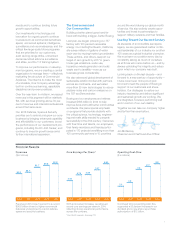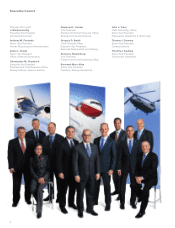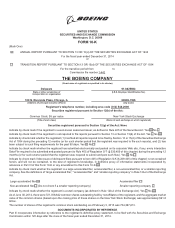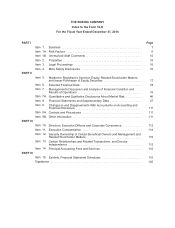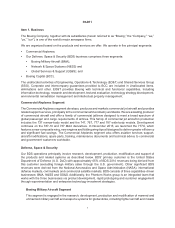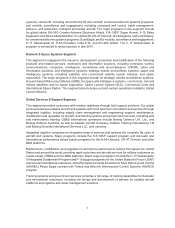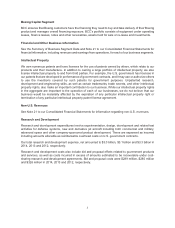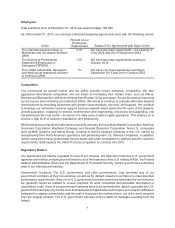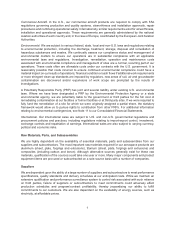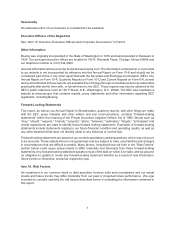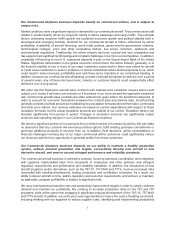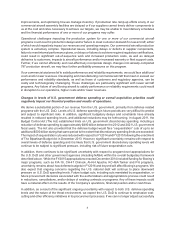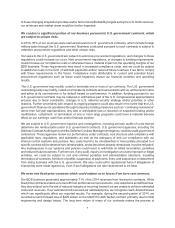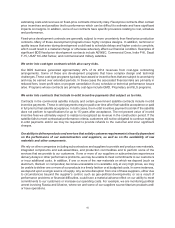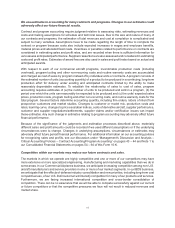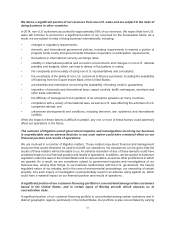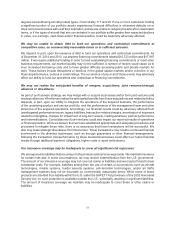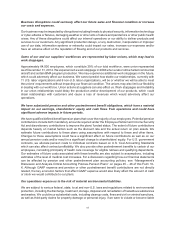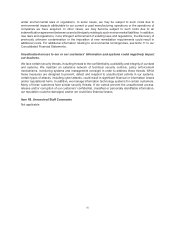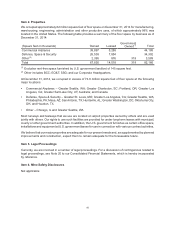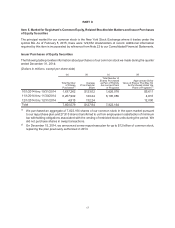Boeing 2014 Annual Report Download - page 19
Download and view the complete annual report
Please find page 19 of the 2014 Boeing annual report below. You can navigate through the pages in the report by either clicking on the pages listed below, or by using the keyword search tool below to find specific information within the annual report.7
Our Commercial Airplanes business depends heavily on commercial airlines, and is subject to
unique risks.
Market conditions have a significant impact on demand for our commercial aircraft. The commercial aircraft
market is predominantly driven by long-term trends in airline passenger and cargo traffic. The principal
factors underlying long-term traffic growth are sustained economic growth and political stability both in
developed and emerging markets. Demand for our commercial aircraft is further influenced by airline
profitability, availability of aircraft financing, world trade policies, government-to-government relations,
technological changes, price and other competitive factors, fuel prices, terrorism, epidemics and
environmental regulations. Traditionally, the airline industry has been cyclical and very competitive and
has experienced significant profit swings and constant challenges to be more cost competitive. In addition,
availability of financing to non-U.S. customers depends in part on the Export-Import Bank of the United
States. Significant deterioration in the global economic environment, the airline industry generally, or in
the financial stability of one or more of our major customers could result in fewer new orders for aircraft
or could cause customers to seek to postpone or cancel contractual orders and/or payments to us, which
could result in lower revenues, profitability and cash flows and a reduction in our contractual backlog. In
addition, because our commercial aircraft backlog consists of aircraft scheduled for delivery over a period
of several years, any of these macroeconomic, industry or customer impacts could unexpectedly affect
deliveries over a long period.
We enter into firm fixed-price aircraft sales contracts with indexed price escalation clauses which could
subject us to losses if we have cost overruns or if increases in our costs exceed the applicable escalation
rate. Commercial aircraft sales contracts are often entered into years before the aircraft are delivered. In
order to account for economic fluctuations between the contract date and delivery date, aircraft pricing
generally consists of a fixed amount as modified by price escalation formulas derived from labor, commodity
and other price indices. Our revenue estimates are based on current expectations with respect to these
escalation formulas, but the actual escalation amounts are outside of our control. Escalation factors can
fluctuate significantly from period to period. Changes in escalation amounts can significantly impact
revenues and operating margins in our Commercial Airplanes business.
We derive a significant portion of our revenues from a limited number of commercial airlines. We can make
no assurance that any customer will exercise purchase options, fulfill existing purchase commitments or
purchase additional products or services from us. In addition, fleet decisions, airline consolidations or
financial challenges involving any of our major commercial airline customers could significantly reduce
our revenues and limit our opportunity to generate profits from those customers.
Our Commercial Airplanes business depends on our ability to maintain a healthy production
system, achieve planned production rate targets, successfully develop new aircraft or new
derivative aircraft, and meet or exceed stringent performance and reliability standards.
The commercial aircraft business is extremely complex, involving extensive coordination and integration
with suppliers, highly-skilled labor from thousands of employees and other partners, and stringent
regulatory requirements and performance and reliability standards. In addition, the introduction of new
aircraft programs and/or derivatives, such as the 787-10, 737 MAX and 777X, involves increased risks
associated with meeting development, testing, production and certification schedules. As a result, our
ability to deliver aircraft on time, satisfy regulatory and customer requirements, and achieve or maintain,
as applicable, program profitability is subject to significant risks.
We must meet planned production rate and productivity improvement targets in order to satisfy customer
demand and maintain our profitability. We continue to increase production rates for the 737 and 787
programs, while at the same time engaging in significant ongoing development of the 787-10, 737 MAX
and 777X aircraft. In addition, we continue to seek opportunities to reduce the costs of building our aircraft,
including working with our suppliers to reduce supplier costs, identifying and implementing productivity


